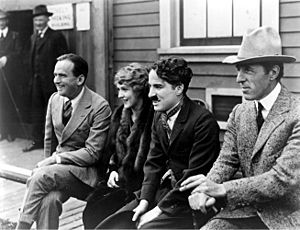United Artists facts for kids
 |
|
|
Trade name
|
|
|---|---|
| Subsidiary | |
| Industry | Film |
| Founded | February 5, 1919 in Hollywood, Los Angeles, California, United States (original; as United Artists Corporation) July 26, 2024 (relaunch; under the United Artists label) |
| Founders | |
| Defunct | 2020 (original) |
| Headquarters |
,
United States
|
|
Key people
|
Scott Stuber |
| Products | Motion pictures |
| Parent |
|
| Divisions |
|
United Artists (often called UA) is an American company that makes and distributes movies. It is currently owned by Amazon MGM Studios. The company was first started in February 1919 by famous actors and filmmakers like Charlie Chaplin, D. W. Griffith, Mary Pickford, and Douglas Fairbanks. They wanted to create a company where actors and directors could have more control over their movies and money, instead of relying on big studios.
Over the years, United Artists went through many changes in ownership. In 1981, it was bought by Metro-Goldwyn-Mayer (MGM). The United Artists name was used for different parts of MGM's business, including a television production group called United Artists Media Group and a digital studio called United Artists Digital Studios.
In 2019, a company called United Artists Releasing was formed as a partnership between MGM and Annapurna Pictures. This company helped distribute movies. However, in 2023, Amazon, which now owns MGM, brought United Artists Releasing fully into MGM. In July 2024, Amazon MGM Studios announced that the United Artists name would be used again for new movies, with producer Scott Stuber leading the way.
Contents
- The Story of United Artists
- United Artists Films
- United Artists on Video
- United Artists Broadcasting
- United Artists Releasing
- See also
The Story of United Artists
Starting a New Kind of Studio
In 1918, famous actors like Charlie Chaplin, Mary Pickford, and Douglas Fairbanks felt that big movie studios had too much control. They wanted to make their own movies and have more say in their creative work. Along with director D. W. Griffith, they decided to start their own company.
On February 5, 1919, they officially created United Artists. Each of the four founders owned a part of the company. Their goal was to let artists control their own films, which was a new idea at the time. One movie boss reportedly joked, "The inmates are taking over the asylum!"
At first, they planned for each star to make five movies a year. But movies became more expensive to make, so this goal was changed. United Artists' first movie, His Majesty, the American, starring Douglas Fairbanks, was a hit. However, getting money for new movies was hard, so the company released only about five films a year in its early days.
By 1924, D. W. Griffith had left the company. To help, Joseph Schenck, an experienced producer, became president. He brought in films starring his wife, Norma Talmadge, and his brother-in-law, Buster Keaton. Other independent filmmakers like Samuel Goldwyn and Howard Hughes also signed deals with UA.
United Artists also started to grow internationally, opening offices in Canada and Mexico. By the end of the 1930s, UA was working in over 40 countries.
Changes and Challenges
In the late 1930s, some of the original partners and producers started to leave. For example, Walt Disney Productions and Samuel Goldwyn Productions moved their films to other studios.
United Artists faced financial problems in the 1940s. Fewer people were going to the movies because television was becoming popular. The company even sold its movie distribution business in Mexico.
Helping Independent Filmmakers
In 1941, many independent filmmakers, including some from United Artists, formed a group called the Society of Independent Motion Picture Producers (SIMPP). This group wanted to help independent producers in an industry mostly controlled by a few large studios.
SIMPP fought against unfair practices by these big studios. In 1948, the U.S. Supreme Court made a big decision that forced major Hollywood studios to sell their movie theaters. This ruling helped end the "studio system," which gave studios too much control over movies. By 1958, SIMPP had achieved its goals and stopped operating.
A New Beginning with Krim and Benjamin
In 1951, two lawyers, Arthur B. Krim and Robert Benjamin, took over United Artists. They had a new idea: UA would be a studio without actually owning a studio lot. Instead, they would lend money to independent filmmakers to make movies. This meant UA didn't have the high costs of maintaining a large studio.
Their new approach quickly led to success. UA released popular films like The African Queen (1951) and High Noon (1952). The company started making a profit again. In 1955, Charlie Chaplin sold his share of the company, and Mary Pickford sold hers a year later.
In the late 1950s, UA had more hits, including Marty (1955), which won an Oscar for Best Picture, and 12 Angry Men (1957). By 1958, UA was making millions in profits each year.
Becoming a Public Company
United Artists became a public company in 1957, meaning people could buy shares in it. The company was releasing about 50 films a year. UA also started United Artists Records in 1957 and a television division in 1959.
In the 1960s, while many other studios struggled, UA did very well. It won 11 Academy Awards, including five for Best Picture. UA released West Side Story in 1961, which won ten Oscars.
UA's television division created popular shows like Gilligan's Island and The Fugitive. They also bought the rights to many old Warner Bros. cartoons and Popeye cartoons.
In 1964, UA introduced American audiences to the Beatles by releasing their films A Hard Day's Night and Help!.
UA also helped launch the famous James Bond franchise with the movie Dr. No in 1963. Other successful series included The Pink Panther films and "Spaghetti Westerns" that made Clint Eastwood a star.
Under Transamerica Ownership
In 1967, a large company called Transamerica Corporation bought most of United Artists' stock. UA continued to release successful movies like In the Heat of the Night (1967), which won a Best Picture Oscar.
UA also worked with new talented filmmakers like Woody Allen, Robert Altman, and Sylvester Stallone. In the 1970s, UA had a string of hits with the James Bond, Pink Panther, and Woody Allen films.
In 1973, United Artists took over distributing MGM's films in North America.
In 1975, UA agreed to release One Flew Over the Cuckoo's Nest, which many other studios had turned down. This film won the Best Picture Academy Award and became UA's highest-earning film at the time. UA then won the Best Picture Oscar for the next two years in a row with Rocky and Annie Hall. This made UA the first studio to win the award three years in a row.
However, Transamerica was not happy with some of UA's movies that were rated for mature audiences. In 1978, many of UA's top executives, including Arthur Krim and Robert Benjamin, left the company after disagreements with Transamerica. They went on to form a new company called Orion Pictures.
Despite these changes, UA had a very successful year in 1979 with hits like Rocky II, Manhattan, and Moonraker.
Then came Heaven's Gate, a movie that went way over budget and cost $44 million. This film was a huge financial failure and damaged UA's reputation. Because of this, Transamerica decided to sell United Artists in 1980.
Joining MGM
In 1981, Kirk Kerkorian's company, Tracinda Corp., bought United Artists. Tracinda also owned Metro-Goldwyn-Mayer (MGM). The two studios merged and became known as the MGM/UA Entertainment Company.
In 1983, the new MGM/UA had big hits with WarGames and Octopussy. However, the company still faced financial challenges.
Turner's Ownership and Sale
In 1985, Ted Turner announced that his company, Turner Broadcasting System, would buy MGM/UA. Turner was mainly interested in MGM's large library of films for his TV channel. As part of the deal, Turner immediately sold United Artists back to Kirk Kerkorian.
On March 25, 1986, Turner completed his purchase of MGM/UA. Kerkorian then bought back most of United Artists' assets. This meant the original United Artists company, as it was known, essentially ended. Kerkorian created a new company using the UA name and its assets.
Due to financial concerns, Ted Turner had to sell MGM's production and distribution parts back to United Artists in August 1986. Turner kept the MGM films made before May 1986 and other film libraries. United Artists then announced it would start making films again.
The company was renamed MGM/UA Communications Company. Despite some successful films in 1987 like Spaceballs and The Living Daylights, the company lost money. Many executives started to leave, and film productions were canceled. After several failed attempts to sell the company, UA became mostly inactive after 1990.
The 1990s and 2000s
In 1990, an Italian financier named Giancarlo Parretti bought MGM/UA. However, his ownership led to many problems, including unpaid debts and delays in films. In 1992, his main lender, Crédit Lyonnais, took control of the studio.
To make MGM/UA ready for sale, Crédit Lyonnais increased film production. They brought in John Calley to run UA. Under his leadership, the Pink Panther and James Bond movie series were revived. In 1996, Kirk Kerkorian bought MGM again.
In 1999, UA was changed into a "specialty studio" focusing on art films. MGM had bought The Samuel Goldwyn Company, which was known for distributing these types of films. The first art film released under the UA name was Things You Can Tell Just by Looking at Her.
In 2005, a group of companies including Comcast and Sony bought United Artists and MGM for $4.8 billion. Sony then took over most of MGM's distribution.
United Artists Entertainment
On November 2, 2006, MGM announced that actor Tom Cruise and his producing partner Paula Wagner were bringing United Artists back to life. They formed United Artists Entertainment LLC, and Cruise and Wagner owned 30% of the studio. Wagner became the CEO, planning to release about four films a year. Cruise would produce and sometimes star in these movies.
However, in August 2008, Paula Wagner left UA to produce films on her own. During her time as head of UA, only two films starring Tom Cruise were released: Lions for Lambs and Valkyrie.
Since then, UA has mostly served as a co-producer with MGM for a few films, like the 2009 remake of Fame. In 2011, MGM fully reacquired its ownership of United Artists.
United Artists Media Group and Digital Studios
In 2014, MGM bought a large part of two television companies run by Mark Burnett and Roma Downey. These companies were combined to create a new television company called United Artists Media Group (UAMG), bringing back the UA brand for TV. UAMG distributed popular shows like Survivor.
In 2015, MGM bought the rest of UAMG and combined it with its own television division.
In 2018, MGM briefly revived the United Artists brand as United Artists Digital Studios for a web series called Stargate Origins.
United Artists Today
In July 2024, Amazon MGM Studios announced that the United Artists name would be used again for new movies. Producer Scott Stuber signed a deal to make films for this newly revived company. These films will be released in theaters or on Amazon Prime Video.
United Artists Films
Most of the films United Artists released after 1952 are now owned by MGM. However, many of the films made before 1952 were sold to other companies or are now in the public domain (meaning anyone can use them freely). Throughout its history, UA often acted more as a distributor, meaning it helped other companies release their films. This is why some UA releases are owned by different companies today.
United Artists on Video
United Artists first allowed its films to be released on home video by a company called Magnetic Video. Later, this company became part of 20th Century Fox Home Entertainment. Even after MGM bought UA, the video deals continued for a while. Eventually, MGM/UA Home Video started releasing UA films.
United Artists Broadcasting
United Artists also owned and operated a few television stations and a radio station for a period. They owned TV stations in Cleveland, Ohio, and San Juan, Puerto Rico, and a radio station in Philadelphia, Pennsylvania. United Artists left the broadcasting business in the late 1970s.
United Artists Releasing
United Artists Releasing, LLC (UAR) was a company that distributed films. It was a partnership between MGM and Annapurna Pictures, started in 2017. In 2019, it was renamed United Artists Releasing to celebrate 100 years since United Artists was founded. This company offered services to filmmakers who wanted to release their movies in theaters.
In 2021, Amazon bought MGM Holdings, which included United Artists Releasing. Then, in March 2023, Amazon combined United Artists Releasing fully into MGM. This was done to help MGM focus on releasing more movies in theaters, alongside Amazon's streaming service, Amazon Prime Video.
See also
 In Spanish: United Artists para niños
In Spanish: United Artists para niños
- List of United Artists films







